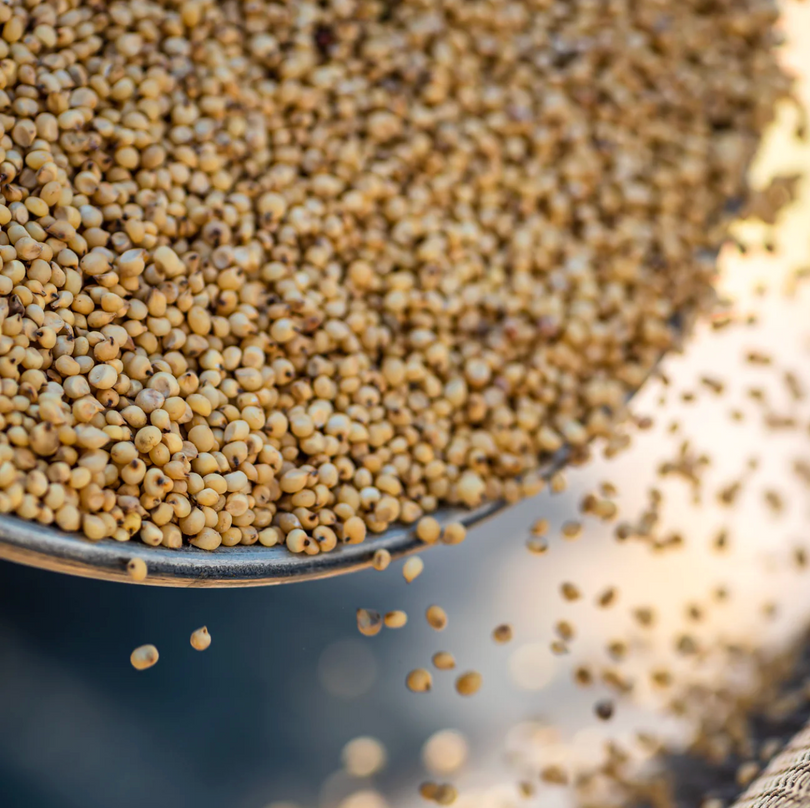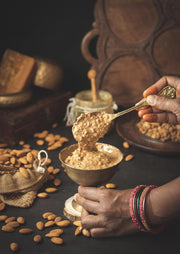Rajma, a staple in Indian cuisine, is not only delicious but also packs a punch when it comes to health benefits. Whether you prefer the kidney-shaped red rajma or the smaller pinkish-brown variety known as pinto beans, this legume offers an array of nutrients that can boost your overall well-being. From providing a rich source of protein and fibre to aiding in weight management and promoting heart health, rajma has captured the attention of nutritionists worldwide.
In this article, we will explore the various types of rajma beans available along with their distinct characteristics and delve into their impressive nutritional value - truly making them a versatile and nutritious addition to any diet.
Rajma Nutritional Value Per 100g
Kidney beans are filled with fibre and carbs and are an excellent source of protein. Here is the list of nutritional values rajma carries to make it the ultimate favourite comfort food of every Indian:
|
Nutrients (Per 100g) |
Rajma Nutritional Value |
|
Calories |
333 kcal |
|
Sodium |
24 mg |
|
Fat |
0.8 gm |
|
Potassium |
1,406 mg |
|
Carbohydrate |
60 gm |
|
Protein |
24 gm |
|
Dietary Fibre |
25 gm |
Types of Rajma Beans
We are all familiar with our good old trustworthy rajma beans and the nutrition in rajma. But did you know there are several types of rajma beans? If you are tired of eating the same plain rajma, you can try the following varieties:
1. Chitra Rajma
Light brown with red speckles or lines, the Chitra rajma type is mostly harvested in the Himalayan region and found in majority of Kashmiri cuisine. It carries a moderate flavour and is high in protein and vitamins. Compared to other rajma types, this kidney bean is easier to cook and must be soaked in water for at least 4 to 6 hours before cooking. Besides being visually appealing, the Chitra rajma variety contains iron, potassium, fibre, protein, vitamin C, magnesium, and vitamin B.
2. Jammu Rajma
Smaller in size, the Jammu Rajma variety has a glossy appearance along with a rich aroma. Similar to the Chitra rajma, this type of rajma has the same nutritional value but has a taste that's sweeter than its former variety. To ensure you can take advantage of this flavourful delight as a whole, you need to soak Jammu rajma in water for six to eight hours before cooking them.
3. Red Rajma
Also known as Waghya rajma, this rajma type is similar to the Jammu rajma. With a rich red colour, the Red rajma is one of the most common kidney bean types and is widely used in various Indian dishes. It has a dense taste and a thick texture, making it necessary to soak it in water for eight to ten hours or overnight before cooking. The best part about the Red Rajma type is that it has a low glycaemic index, making it suitable for people with diabetes.
4. Pinto Beans
Not native to India, the Pinto beans are more common in South American and Mexican cuisine. This doesn't stop Indians from using this rajma type in Indian cuisine. These brown coloured beans are larger and longer than our normal rajma beans and have a thick heavy flavour, making them a perfect bean type for salads.
Rajma Benefits for Health
1. Manages Weight
Kidney beans are known to be filled with protein. With a whopping 24 gm protein content in 100g of rajma serving, kidney beans are a great source of protein, helping produce enough energy and growing muscle in your body. Further, rajma is also an excellent aid in weight loss or if you are looking for weight management since its heavy protein content helps keep you full for longer, thus eliminating binge eating.
2. Keeps Your Bones Strong
Another health benefits of rajma seeds is that it is high in calcium, helping you maintain the health of your bones. Like any other mineral, even calcium is secreted from your body with excess water but replaced with calcium in the bloodstream. But when this replaced calcium is not abundant in your body, your bones become weak and lose their strength. Adding rajma to your diet can help you gain calcium to replace the secreted calcium, improving bone health.
3. Improves Digestive Health
While you may have heard and felt lethargic and bloated after eating rajma, the surprising fact is that rajma indeed helps you improve your digestive health! Along with dietary fibre and high protein, rajma beans also act as probiotics, slowing down your digestion and letting the nutrients in them truly get absorbed in your body.
But if it's good for your stomach, why do you feel sluggish after having a good bowl of rajma? The problem lies with the presence of oil and heavy spices in it. Spices and oil make any rajma type a heavy dish. Also, since rajma is delicious in taste and everyone's favourite, you may even end up overeating, resulting in a heavy feeling.
4. Benefits Your Skin
Apart from your health, rajma beans also benefit your skin. The presence of folic acid in kidney beans makes them a great food for your skin and may help delay ageing effects like dullness and wrinkles.
5. Assists in Treating Arthritis
Rajma beans benefit you by increasing the presence of copper in your body. They are a great source of copper, and for this reason, rajma might help you fight against arthritis. Since arthritis is caused by inflammation in your joints, which is a side-effect of lack of copper in your body and other reasons, rajma can help aid your arthritis treatment by supplying a good amount of copper.
6. Reduces Risk of High Cholesterol
The soluble fibre in rajma beans benefits you by keeping bad cholesterol in check and preserving your cardiovascular health. Since your body does not easily digest soluble fibre, it gets into the intestines and sticks with bad cholesterol, removing it along with them from your body.
7. Manages Blood Pressure
Potassium in rajma may help keep your blood pressure in check by lessening sodium effects in your body and regulating blood pressure.
8. Great for Diabetic Patients
Another health benefit of rajma is its property of being an excellent food for diabetes patients. Since it's a complex carb, it has a low glycaemic index and slows down the process of releasing sugar, therefore not rapidly raising blood sugar levels.
How to Make Rajma?
As an Indian, you know the most famous dish in India is "rajma-chawal." Rajma masala or rajma gravy is most commonly eaten with rice in India and is a widely popular dish in the country, especially in North India. But what else can be made using these protein-rich beans? Here are some other dishes you can try to make with rajma:
1. Rajma Salad
Who said rajma is only meant to be eaten with heavy spices and oil in order to enjoy it? If you are a health-conscious individual who prefers limiting masala in your diet, boiling rajma and adding corn, lettuce, and other vegetables can give you a nice and nutritious bowl of yummy health.
2. Rajma Chaat
Make a chaat out of kidney beans by boiling rajma and adding lemon and spices! This snack is an amazing alternative to chana chaat.
3. Kidney Bean Burrito
Mexican, but make it Indian! Bring the best of both worlds to your plate by adding rajma beans to your leftover roti, other vegetables, and sauces and rolling it into a burrito.
4. Rajma Soup
We all have heard about corn soup, but have you ever tried eating rajma soup? Use kidney beans and other vegetables like tomatoes and corn to make your soup tasty and healthy.
FAQs: Types of Rajma Beans and Rajma Benefits
Is Rajma Good for Weight Loss?
Rajma might be a great food for managing your weight because of its high fibre and protein content.
Which Rajma Is Good For Health?
Red Rajma, also known as kidney beans, is excellent for health. It is rich in essential nutrients like fibre, protein, and various vitamins and minerals, promoting overall well-being.
Different Types Of Rajma?
There are several types of rajma, including Red Rajma, Chitra Rajma, Jammu Rajma, and more. Each type has its unique flavour and texture, offering variety in taste and culinary options.
Which Rajma Is Best In Taste?
Taste preferences vary, but many find the Red Rajma to be the most popular for its slightly sweet and nutty flavour. It's a versatile ingredient that blends well with various spices and recipes.
Which Rajma Is Best For Protein?
Red Rajma is the best choice for protein. It contains a high amount of plant-based protein, making it an excellent option for vegetarians and those looking to increase their protein intake.
Red Rajma Vs Chitra Rajma Which Is Better?
Both Red Rajma and Chitra Rajma have their unique qualities. Red Rajma is known for its protein content, while Chitra Rajma has a distinct appearance. The choice depends on personal preferences, but for higher protein content, Red Rajma is recommended.
What are the benefits of eating rajma?
Rajma offers numerous health benefits, including being rich in protein, fiber, vitamins, and minerals. It can aid in weight management, regulate blood sugar levels, improve heart health, and support digestion.
How much protein in rajma per 100g?
Rajma typically contains approximately 24 grams of protein per 100g serving, making it an excellent plant-based protein source for vegetarians and vegans.
Is rajma rich in nutrients?
Yes, rajma is rich in essential nutrients like protein, fiber, iron, potassium, and folate. These nutrients play a crucial role in maintaining overall health and well-being.



















